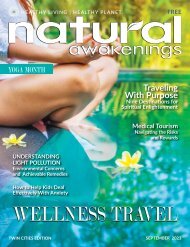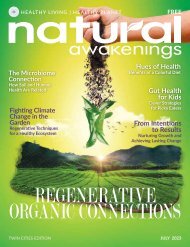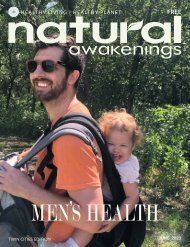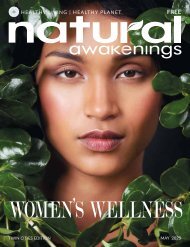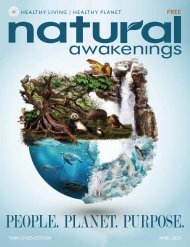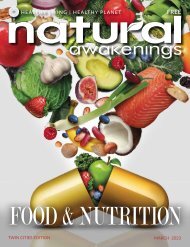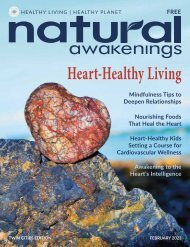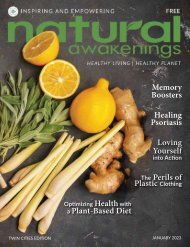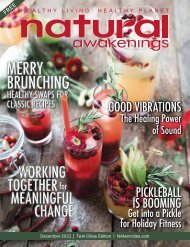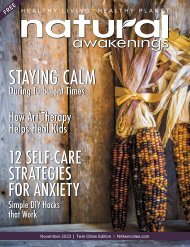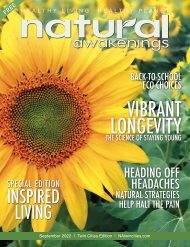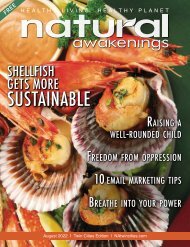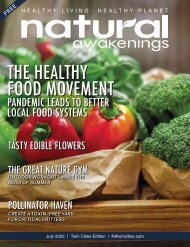Natural Awakenings Twin Cities August 2023
Read the August 2023 edition of Natural Awakenings Twin Cities magazine. This is our annual Self-Empowerment Issue featuring articles on stepparenting success, steps for successful school year transition, lifelong learning, mushroom for fun and health, letting nature heal itself, navigating food restrictions at school and so much more! Be sure to check out our local content, including News Brief announcements, Community Resource Guide with providers throughout the metro who can meet your individual wellness needs, and all the happenings in the Calendar of Events. There is additional online-only content that can be found at NATwinCities.com.
Read the August 2023 edition of Natural Awakenings Twin Cities magazine. This is our annual Self-Empowerment Issue featuring articles on stepparenting success, steps for successful school year transition, lifelong learning, mushroom for fun and health, letting nature heal itself, navigating food restrictions at school and so much more!
Be sure to check out our local content, including News Brief announcements, Community Resource Guide with providers throughout the metro who can meet your individual wellness needs, and all the happenings in the Calendar of Events. There is additional online-only content that can be found at NATwinCities.com.
You also want an ePaper? Increase the reach of your titles
YUMPU automatically turns print PDFs into web optimized ePapers that Google loves.
SPONSORED CONTENT<br />
mushrooms need to be exposed to light in order to synthesize<br />
vitamin D. This is an important factor, as most commercial<br />
button mushrooms are grown in the dark, so unless<br />
they have been exposed to light, they will not convert the<br />
necessary compounds. Wild mushrooms, particularly those<br />
exposed to sunlight, are ideal for promoting health, although<br />
it should be noted that sitting mushrooms at home in a sunny<br />
window for a day or two before eating them will enhance<br />
their vitamin D content.<br />
This information is inspiring because I am continually<br />
trying to find ways to increase the nutrient density of<br />
my food. There has been a lot of attention in recent years<br />
paid to studies indicating that vitamin D is an important<br />
nutrient for maintaining health and many providers of<br />
health care are encouraging their patients to ingest vitamin<br />
D supplements. As with nutrients in general, I prefer<br />
to introduce them through food, not capsules or pills. I<br />
really do trust that with information and creativity, we can<br />
Mushrooms for Health,<br />
Nourishment and Fun<br />
by Linda Conroy<br />
As a big fan of cooking and eating mushrooms, I<br />
remember long hikes during last year’s spring<br />
morel mushroom hunt, the puffball mushrooms<br />
we found in our neighbor’s field last summer and how<br />
abundant the chanterelle mushrooms were in the woods.<br />
We ate mushrooms often, and I am confident our immune<br />
systems were thanking us.<br />
I have long been an avid wild harvester, preferring to<br />
find my food in the woods or fields rather than the grocery<br />
store. Mushrooms made me nervous for a long time.<br />
Prior to moving from the west coast to the Midwest, I was<br />
comfortable harvesting only two types of mushrooms, and<br />
even then I was very careful, as one should be. Today I am<br />
happy to say that I enjoy harvesting 20-plus mushroom<br />
varieties, and each year I add to my repertoire.<br />
I have long been aware of the immune-boosting benefits<br />
of eating mushrooms and know that they contain a<br />
wide spectrum of nutrients, including B vitamins, vitamin<br />
K, copper, potassium, selenium and other trace minerals.<br />
So I was not surprised when I recently read an article in<br />
the Acres USA farming magazine that research is being<br />
conducted on their vitamin D content. Similar to humans,<br />
assimilate the nutrients we need through our food.<br />
So while I will continue to eat whatever mushroom is<br />
presented to me, I am more committed than ever to eating<br />
wild or homegrown mushrooms on a regular basis. If you<br />
decide to harvest your own mushrooms, be sure to consult<br />
a reliable field guide or spend time with someone knowledgeable<br />
about mushrooms. A good book is Start Mushrooming,<br />
by Stan Tekiela, and in many areas you can find<br />
a local mycological society that will offer forays and other<br />
learning opportunities. Also, growing mushrooms outside<br />
your doorstep is a good way to have them readily available<br />
and to learn to recognize them when you do see them in the<br />
wild environment.<br />
Incorporating mushrooms into your diet is fun and<br />
easy. Add them to soups, stews, stir fry vegetables, omelet,<br />
quiche and even stuffed. Use your imagination. I suspect<br />
you can think of many other ideas, as well.<br />
Shiitake mushrooms are one of my favorites for eating.<br />
They are easy to grow and increasingly easy to find at farmers<br />
markets and natural grocery stores. Below is a recipe for<br />
a simple mushroom pate that I love to serve as an appetizer<br />
or for a light lunch.<br />
24 <strong>Twin</strong> <strong>Cities</strong> Edition NAtwincities.com



